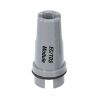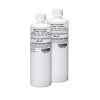Extech ExStik II Conductivity Meter
Features
- Units of measure include μS/cm, mS/cm, ppm, ppt, mg/L, and g/L
- Automatic temperature compensation of 2% per °C
- Self calibration of electronics on power up
- Expedited repair and warranty service
- Lifetime technical support
- More
Overview
The Extech ExStick Conductivity/TDS/Salinity Meter features a high-accuracy multi-range sensor that measures four parameters: conductivity, TDS, salinity, and temperature. The autoranging meter offers 3 ranges of measurements from tap water to wastewater and any aqueous solution. The units of measure include μS/cm, mS/cm, ppm, ppt, mg/L, and g/L.
Data Potential
Adjustable conductivity to TDS ratio is from 0.4 to 1.0 to conveniently calculate the TDS value. The large 2000-count digital display simultaneously displays conductivity, TDS, salinity, and temperature, and uses an analog bar graph to indicate sample trends. The internal memory stores up to 25 labeled readings for easy recall. The conductivity module is easy to replace, and the self-calibration function activates when the meter powers on. Other meter functions include data hold, power off, and low battery indication.
- Conductivity ranges: 0 to 199.9μS/cm, 200 to 1999μS/cm, 2.00 to 19.99mS/cm
- Conductivity maximum resolution: 0.1μS/cm, 1μS/cm, 0.01mS/cm
- Conductivity basic accuracy: ±2% FS
- TDS ranges: 0 to 99.9ppm (mg/L), 100 to 999ppm (mg/L), 1.00 to 9.99ppt (g/L)
- TDS maximum resolution: 0.1ppm (mg/L), 1ppm (mg/L), 0.01ppt (g/L)
- TDS basic accuracy: ±2% FS
- Salinity ranges: 0 to 99.9ppm (mg/L), 100 to 999ppm (mg/L), 1.00 to 9.99ppt (g/L)
- Salinity maximum resolution: 0.1ppm (mg/L), 1ppm (mg/L), 0.01ppt (g/L)
- Salinity basic accuracy: ±2% FS
- Temperature range: 32° to 149°F (0 to 65°C)
- Temperature maximum resolution: 0.1°F/°C
- Temperature basic accuracy: ±1.8°F/1°C
- Power: four CR2032 button batteries
- Dimensions: 1.4 x 6.8 x 1.6" (36 x 173 x 41mm)
- Weight: 3.8oz (110g)
- (1) ExStick Meter
- (1) Protective sensor cap
- (1) Sample cup with cap
- (4) 3V CR-2032 batteries
- (1) 48" neckstrap
In The News
What is Conductivity?
UPDATE : Fondriest Environmental is offering their expertise in conductivity through their new online knowledge base. This resource provides an updated and comprehensive look at conductivity and why it is important to water quality. To learn more, check out: Conductivity, Salinity and TDS. Salinity and conductivity measure the water's ability to conduct electricity, which provides a measure of what is dissolved in water. In the SWMP data, a higher conductivity value indicates that there are more chemicals dissolved in the water. Conductivity measures the water's ability to conduct electricity. It is the opposite of resistance. Pure, distilled water is a poor conductor of electricity.
Read MoreFrom Paddles to Phytoplankton: Studying Vermont’s Wildest Lakes
For six months of the year, Rachel Cray, a third-year PhD student at the Vermont Limnology Laboratory at the University of Vermont, lives between a microscope and her laptop, running data. For the other six months, she is hiking and canoeing four of Vermont’s lakes, collecting bi-weekly water samples. Cray studies algal phenology across four lakes in Vermont, US, that have low anthropogenic stress—or in other words, are very remote. Funded by the National Science Foundation Career Award to Dr. Mindy Morales, the lakes Cray researches part of the Vermont Sentinel Lakes Program, which studies 13 lakes in the area and, in turn, feeds into the Regional Monitoring Network, which operates in the Northeast and Midwest US.
Read MoreReimagining Water Filtration: How Monitoring and Science Enhance FloWater Filtration Systems
Over 50% of Americans think their tap water is unsafe , according to the Environmental Working Group (EWG). Other recent surveys have found that number to be as high as 70% of persons surveyed. Whether due to increased public awareness of water quality issues or confusion about how municipal water sources are regulated, there is a clear distrust of tap water in the United States. According to industry expert Rich Razgaitis, CEO and co-founder of the water purification company FloWater, this issue creates a damaging cycle. Razgaitis explained that the health and environmental problems associated with contaminated water aren’t the only issues. As people become increasingly aware that some tap water is unsafe, they resort to bottled water.
Read More











